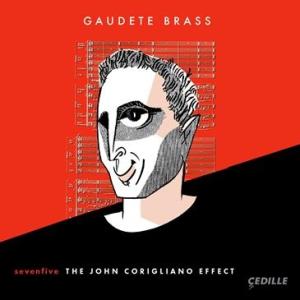Here’s a disc that shows off all the cool things that brass players do: a program of mostly world premieres that features the scnitillating dissonances, the tonguing–triple, quadruple, and god knows octuple and beyond–plops, pops, lip slurs, slides, swoops, blares, and every possible conception of harmony/cacophony/meliphony in sets alternately irreverent, worldly, resolutely traditional or defiantly non-conformist.
This is definitely a disc for brass lovers–and lots of other people too–but you probably won’t love everything: there’s a very wide range of, shall we say “styles”, on display here by these six composers, and as many different approaches to the brass ensemble genre. There’s not even one brass ensemble configuration–while the majority of the nine works are scored for the traditional quintet, two, by the disc’s honoree, John Corigliano (on his 75th birthday), require groups of 10 and 11 players.
The opening Entrance by David Sampson perfectly fulfills its promise and purpose, although the role also could have been played by the following Gazebo Dances Overture–an excellent arrangement for brass quintet by Cliff Colnot of Corigliano’s oft-covered piece for four-hand piano.
Jonathan Newman’s four-movement Prayers of Steel opens with low-register growling and jerky, start-stop rhythm. It gets your attention; however, as with most works whose aim is to depict or imagine something non-musical, you need a guide to tell you that its themes were “inspired by three Carl Sandburg poems”, including one about a train journey and another about industrial Chicago. It doesn’t ultimately matter, because the music, alternately hard-edged, jazzy, light-footed, hymn-like, and propulsive, keeps you engaged for all of its nearly 12 minutes.
Steven Bryant’s Sevenfive begins with some kind of almost-human sound that you can’t place; nor can you quite nail down the rhythmic patterns, but you can–correctly–assume that they are related to the numbers 7 and 5! The piece was commissioned for the composer’s 75th, and the work’s title refers to both intervals and rhythmic structure. Jeremy Howard Beck’s contribution to the project boasts effects such as buzzing and scraping, followed by some of the uglier assertions of brass sound that you will ever hear–well, what do we expect? the title of the piece is ROAR. David Sampson’s Still is a welcome calm from the preceding raging storm.
As with the aforementioned Prayers of Steel, Conrad Winslow’s The Record of A Lost Tribe could be “about” many things, but once we know its theme–“the imaginary history of a bygone civilization”–we can use our imagination to engage with the musical depictions of each of its three movements–“its ruins, its reconstructed history, and its art”. Even so, it’s a bit of a challenge to hang on for the whole 17-minute-plus trip.
The concluding Fanfares to Music, a piece Corigliano wrote for two ensembles (one on-stage, one “in the back of the hall”), fittingly returns us to the more traditional brass ensemble sound and style, its ending a tribute to Schubert’s classic An die Musik. Cedille’s sound delivers the full–you are there–texture and timbre of a real live brass ensemble experience. For brass lovers, definitely; but if you’re willing to be surprised and a bit challenged, for everyone else too.
































